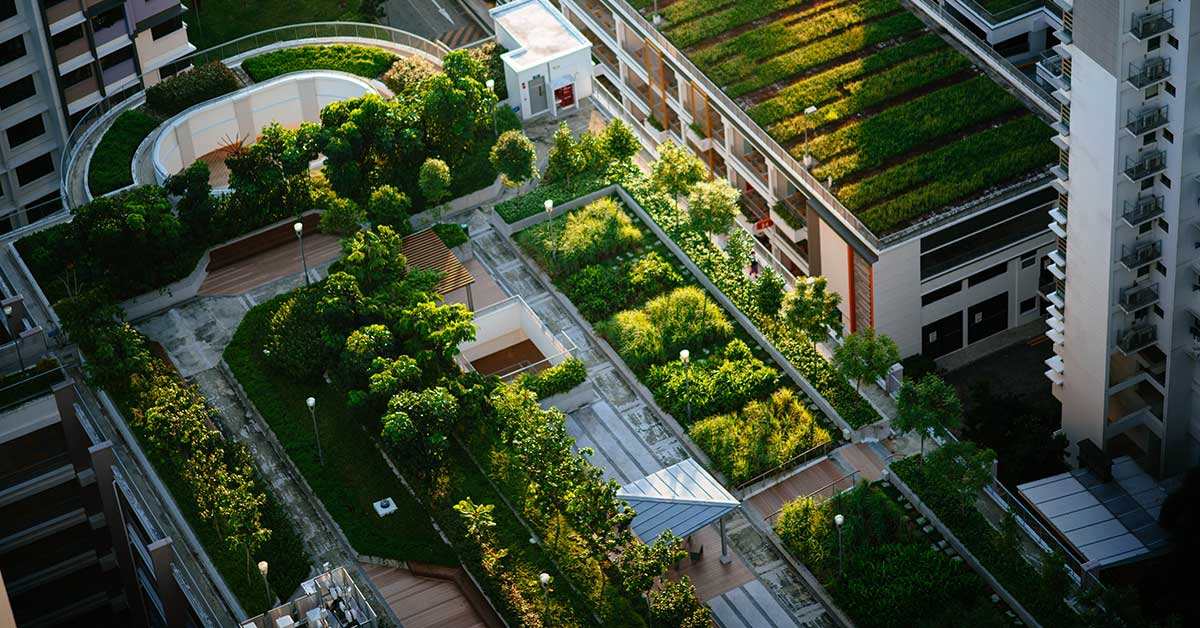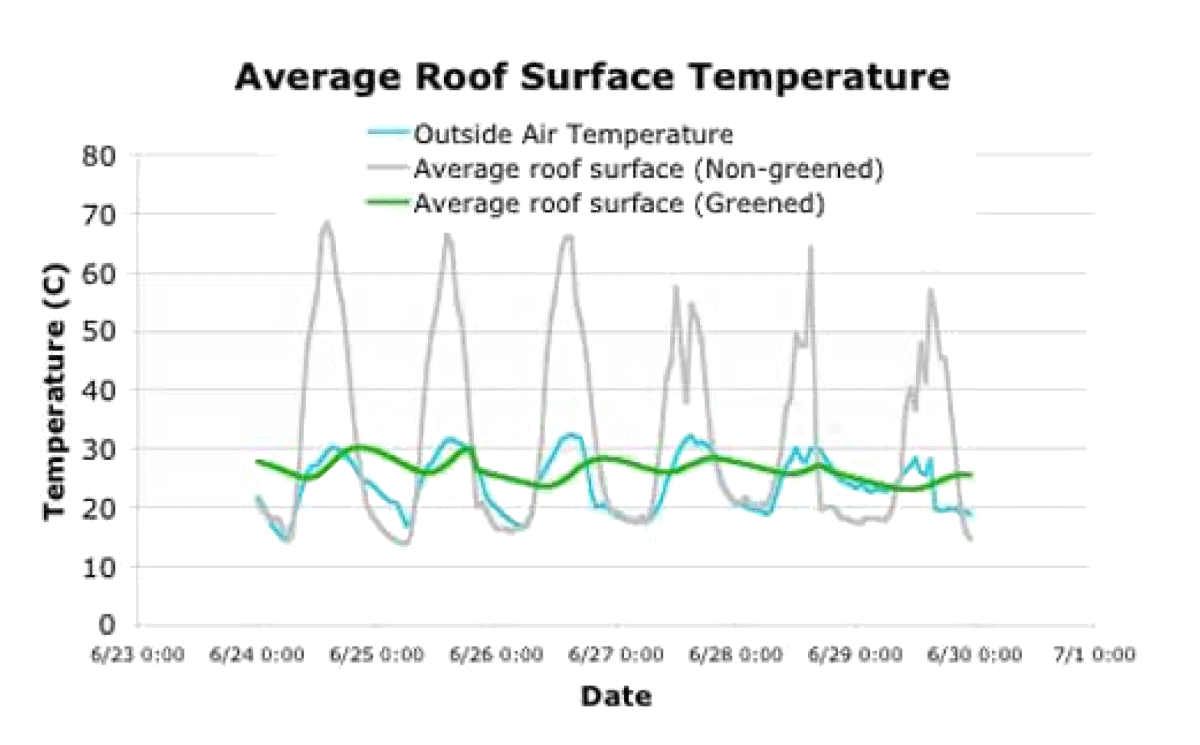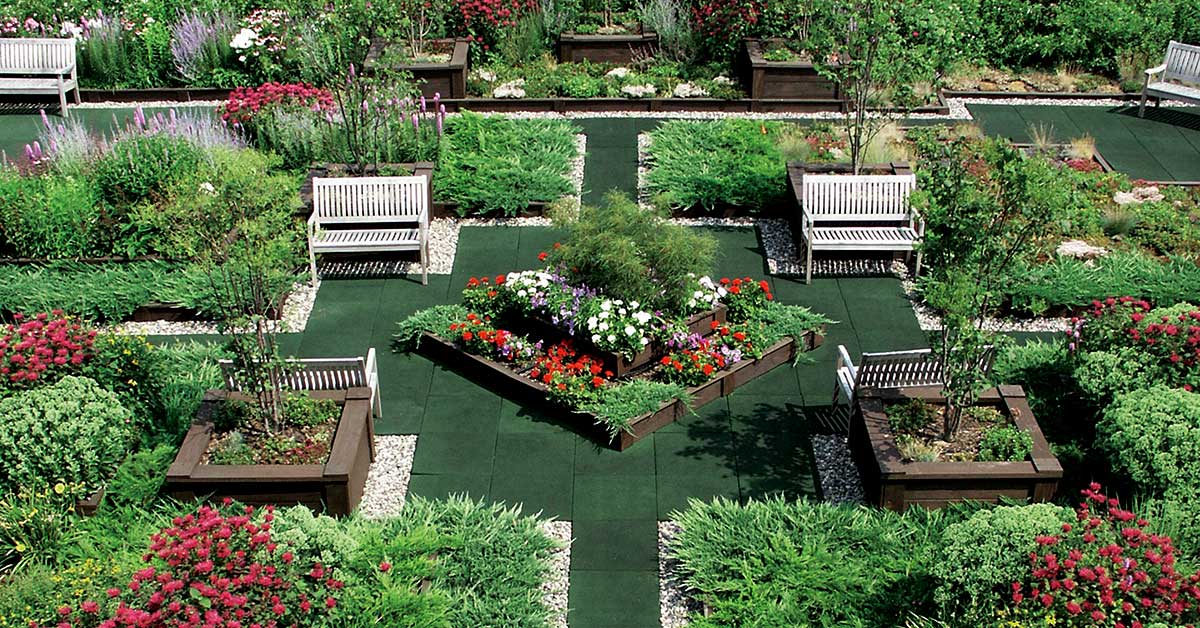
With their rapidly-rising profile in the commercial building space, you are probably already aware of green roofs.
If, however, you haven’t encountered this topic much until now, or could use a refresher, we’ll start with some of the basics. Green roofs are made up of a waterproofing system and a layer of vegetation installed on flat or slightly sloped roofs, and there are three major types.
An extensive green roof is shallow, with a growing medium reaching a depth of six inches or less, whereas an intensive green roof can have a growing medium several feet deep. Intensive green roofs allow for more planting options, including trees, and they will have a heavier structural load than an extensive green roof. Falling somewhere in between is the semi-intensive green roof, which can include features of both types.
Rather than going into the pros and cons of intensive, extensive, and semi-intensive, we’ll cover instead the economic benefits of green roofs and why commercial building owners should consider their addition to existing properties or incorporation into new construction plans.
The Bottom Line
Green roofs are often more expensive upfront, but the long-term benefits more than make up for that initial outlay. Researchers at the University of Michigan determined that a 20,000 square foot green roof would save $200,000 over its 40-year lifespan—yes, you heard that right, 40 years! Europe has been doing green roofs for decades and that’s actually a conservative estimate. In Germany, many green roofs are well over 40 years old.
That $200,000 savings is just from increased longevity, health savings, and stormwater tax credits gained when compared to a conventional roof. If that alone doesn’t convince you, keep reading for even more benefits.
Stormwater Benefits
Increased urbanization is wreaking havoc with municipal stormwater systems. For many older towns and cities with combined stormwater and sewer systems, it’s become a significant environmental and public health crisis.
Overflow can be a problem even in separated systems, where runoff flows directly into lakes or streams, but excessive stormwater in a combined system is potentially disastrous. Rainwater runoff, domestic sewage, and industrial wastewater all go into the same pipe for treatment, which means an overload will cause the city’s sewage system to overflow, discharging sewage into streams and rivers.
A green roof can help alleviate this problem by slowing down the stormwater entering the system. According to the Pennsylvania State University Center for Green Roof Research, green roofs capture up to 80% of rainfall during rainstorms, compared to the 24% typical for standard roofs. Those stormwater retention rates go up as the plants mature.
Check with your municipality for stormwater mitigation requirements for new construction and properties undergoing renovations. There may also be incentives, grants, and low-interest loans for green infrastructure improvements like green roofs.
Environmental Benefits
The environmental benefits of a green roof abound, and they improve the health of the entire ecosystem. A green roof creates a habitat for wildlife, not only enhancing biodiversity and attracting beneficial insects, bees, and butterflies, but also providing a layover for migrating birds.
Green roofs also help lower air temperatures, mitigating the heat island effect in urban areas. Both intensive and extensive green roofs improve air quality by filtering pollutants, toxins, and carbon dioxide.
These benefits increase public goodwill for the organizations that include green roofs in their building and renovation plans.
Energy Conservation Benefits
Research gathered by the National Park Service (NPS) tells us that green roofs can reduce energy consumption by up to 20%. A traditional, heat-absorbing roof surface increases the difficulty of maintaining a comfortable temperature, requiring the building’s cooling system to work harder and increasing costs. In contrast, a green roof reduces the roof’s temperature and, in turn, that of the building itself, while also serving as an insulator. In warm climates, that means less heat passing into the building, and in cool temperatures, more heat staying in. The higher your roof-to-wall ratio, the greater the energy savings benefits.

The NPS also tells us that a green roof’s cooler temperatures increase the efficiency of rooftop mechanical equipment. If the air is cooler on the roof, less energy is expended to pre-cool the outside air to the required indoor temperature.
Traditional roofs are the site of the most significant heat loss in winter and the hottest temps in the summer. However, the National Research Council of Canada discovered that an extensive green roof reduced the daily energy demand for air conditioning in the summer by over 75%.
Green Roofs for Healthy Cities found that a green roof will decrease the exposure of waterproofing membranes to both large temperature fluctuations, which can cause micro-tearing, and to ultraviolet radiation. In addition, green roofs improve fire retardation, having a much lower burning heat load than conventional roofs.
According to Princeton Environmental Institute’s Energy and Climate Scholars, “improving energy efficiency decreases the amount of energy needed to provide services for an institution.” In other words, when less energy is needed to heat and cool buildings, the direct result is a reduction of on-site combustion or the amount of electricity purchased from the grid, thereby lowering emissions.
Lifestyle & Added Income Benefits
An intensive green roof enhances a building’s aesthetic appeal, increasing its perceived value and creating more accessible park space in urban areas. Any type of green roof is beneficial to those living and working in the building—it not only serves as a buffer, reducing outside city noise, but the experience of looking out over a natural landscape helps lower stress.
Many building owners take advantage of these bonuses and use adjacent space for additional business opportunities. The 1.25-acre Cira Green was constructed atop a parking garage which connects the two skyscrapers making up Cira Center South in Philadelphia—Evo, the nation’s tallest student housing tower, and FMC Tower, a mixed-use high-rise. Up to 500 people can safely gather in this grassy park high above the busy streets, providing a place where friends can get together for a bocci ball tournament, watch a movie, grab a bite to eat, enjoy a cocktail, or join a yoga class.
However, it wasn’t the potential income source that brought the park into being, but rather the need to manage stormwater runoff. The city of Philadelphia not only has stormwater management requirements for construction, but the Philadelphia Water Department also changed its stormwater fee structure for large commercial buildings. Instead of paying by metered sewer usage, building owners are now charged based on the amount of impervious structure.
Chris Franklin, Brandywine’s director of construction on the Cira Green project, told the Urban Land Institute, “We saved easily half a million dollars on pure stormwater system construction costs for Evo, not even including the difficult task of designing and engineering a system within these constraints.”
Wrapping Up
What building owner wouldn’t like to hear about potential for savings like that from their contractor?
Between savings on stormwater management and energy conservation, increased income potential, and environmental benefits—and the goodwill that comes with them—we hope you are convinced that green roofs should become a common sight here in North America.
For more in-depth information on green roof drainage systems, download our brochure below or send us a message—our engineers will be more than happy to discuss your project with you!

